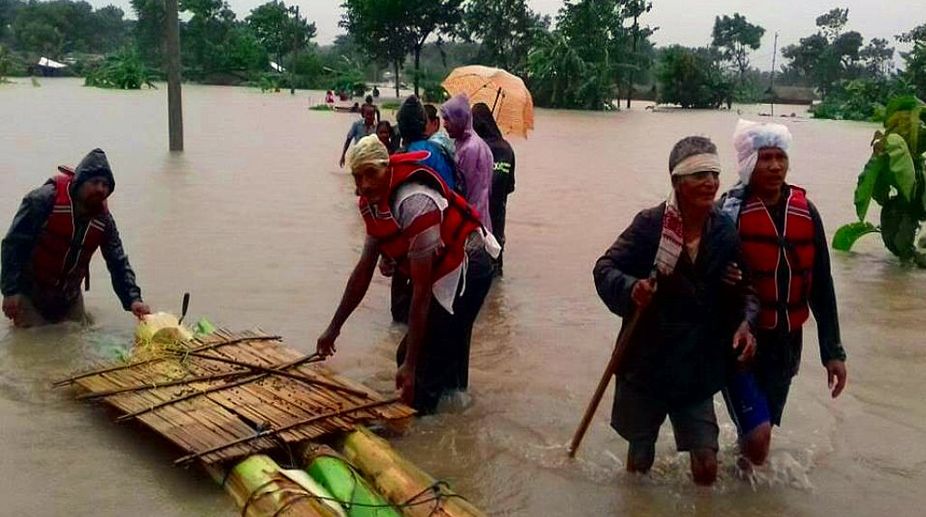Bangladeshi passenger dies in Maitree Express
A Bangladeshi passenger fell ill and died after boarding the Maitree Express on his way home.

(Photo: Twitter)
Long considered one of the global leaders in disaster management, the deaths from this year’s floods have been traumatic for Bangladesh — with many happening in areas not considered to be “flood prone”.
The Department of Disaster Management said that as of August 17, 61 people, including many children, died in the floods that affected 26 districts.
At least 42 people drowned in the northern districts of Dinajpur and Kurigram alone as vast swathes of the two highland regions was inundated by the Brahmatputra, the Teesta, the Punarbhaba, Atrai, Tangon and other rivers entering Bangladesh from India. The weeks of torrential rain inside Bangladesh aggravated the ongoing flood that has been inundating the northern tip since August 12.
Advertisement
“In less than two days, water crossed through the windows of our house. We are not used to floods (here),” said Mozammel Hossain, 55, a resident of Dinajpur, most of which has been under at least five feet of water for days.
According to the Department of Disaster Management, 4.8 million people in 26 districts would see inundation as waters recede from the northern regions.
Saiful Hossain, a superintendent engineer at the flood forecasting and centre, said that the flood situation in the north was likely to improve, while the situation will worsen in the central, southern and southwestern parts of the country. “The flood will continue for at least four days,” he said.
The deaths in Dinajpur and other northern districts could have been prevented if forecasts of severe incoming floods were communicated to the people, as had been done in previous years, water expert Ainun Nishat told thethirdpole.net.
“Dinajpur is not flood-prone,” said Nishat. “There was a flood there 30 years ago (in 1987 and 1988). People in the district have forgotten the memory of it, their capacity to cope with floods is lost. The depth of the major river in the greater Dinajpur area such as the Punarbhaba, the Tangon and the Atrai has also come down; the water-holding capacity of the rivers has been reduced.”
The 1988 flood was the worst in Bangladesh history. The two spells of floods affected around 45 million people across the country, including in the northern region. At least 1,470 died in 1987 while 1,621 died the following year. As many as 347 sub-districts in 50 districts were affected in 1987.
But in the following 30 years, flood protection embankments in Dinajpur were not maintained as the area was not affected by flooding.
“The rivers (in the greater Dinajpur area) carry bulk waters from upstream in India that experienced heavy rains this year, putting extra pressure on the rivers. The embankment collapsed due to huge pressure of waters,” said Nishat, who added that the latest flooding in the northern region is a lesson for Bangladesh.
“All flood protection embankments must be maintained every year, no matter whether flooding is happening or not. If the embankments are maintained properly, people could get enough time to move to safer places. Such loss of life could be prevented,” he said.
After the 1987 flood, the government developed a comprehensive plan to develop a flood forecasting and warning system, with the help of the international community. In order to improve the flood forecasting and warning system, Bangladesh reached out to India, China, Nepal and Bhutan — the countries sharing the Brahmaputra, the Ganga and Meghan river basins.
“Sharing data on transboundary rivers helps us better prepare for floods and reduce damages and loss of lives,” said Saiful Hossain, an engineer at the flood forecasting and warning system of the Water Development Board.
Shantu Miah, 65, a farmer in Birol, Dinajpur, said that the death toll and damage caused by the floods would have been reduced if the government would stop constructing houses on the floodplains.
The rural poor have been continuing the practice of building houses in low-lying countryside areas, because the price of land in the floodplains is lower. Many people sell their homesteads in the highlands to rich clients hungry for land as the pace of urbanisation increases. The people then shift their houses to the low-lying floodplains and the become victims of floods.
This practice has been pervasive across the country. For instance, the DND (Dhaka-Narayanganj-Demra) project in the outskirts of Dhaka was originally developed on a low-lying land for agricultural purposes. But the people made it a residential purpose.
The area now faces severe waterlogging and frequent flooding. “If we build houses on the low land and ditches, flood is sure to damage the houses and kill people,” said Miah.
Advertisement